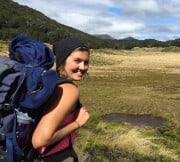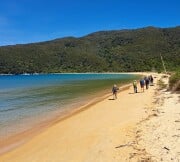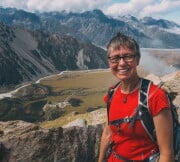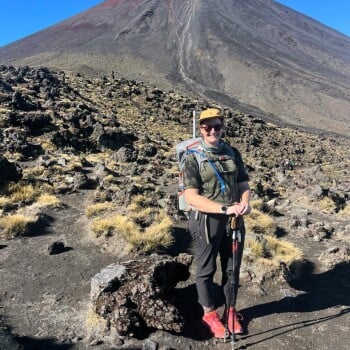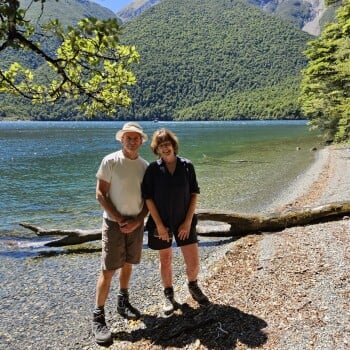
Backpacking in New Zealand
(hiking - trekking - tramping)
Hiker with lost mind
Hiking New Zealand director Malcolm muses on why New Zealand is so incredibly popular when it comes to backpacking, yet it is annoyingly distant from the rest of the world. This gives it a poor starting score - so what's going on here – is the hiking experience truly unique in New Zealand or have people lost their minds?
Someone pass me a dictionary
Is it trekking or hiking or backpacking in New Zealand?

Mt Cook National Park
Different countries, different words. If you want to talk multiple days of travel through the wilderness staying in huts or camping, then here's where we’re currently at with regards terminology. As the world shrinks and becomes increasingly ‘connected’, these terms (and the cultures that use them) are becoming more integrated.
Backpacking – a term used in North America. This is not the case in New Zealand, where backpackers are budget tourists who typically get around the country with a backpack not a suitcase.
Tramping - used in New Zealand (note a 'tramp' is a hiking expedition in NZ, and a homeless person in the USA - be wary!)
Bush walking - mainly used in Australia and some say South Africa too.
Hiking (overnight hikes) - UK, USA, and Africa (becoming more common in NZ).
Trekking (denotes a longer journey) - all nations, but applied more to Himalaya/South America. A trek is not necessarily wilderness either, it can be village to village.
Six things that make Backpacking in New Zealand different (and wonderful)
(No) Trains, Planes and Automobiles
Following river valleys is often the fastest route of travel
Generally backpacking on trails in New Zealand’s National Parks and on conservation land (one third of the country) is the only way to see the wilderness. The topography is severe in the backcountry, the forest dense, and unless you use trails or walk up the actual rivers, you cannot traverse it. This means the place is too rugged for farms, there are rarely off-roaders, no snowmobiles and no 4wd tracks.
So unlike most places you go to hike, in New Zealand you can truly experience the feeling of remoteness. You get tranquility, separation and the sense that this place is just the same now as before humans got here. This is what is simply and unforgettably 'pure New Zealand'.The only time an engine will be heard is the odd helicopter or perhaps a water taxi providing access across some of the lakes and fjords. Our National Parks are strictly parks and no items of civilisation are allowed to linger - and no drones without permits. We could be considered a smidge purist compared to other nations. Fine by me, but if it is a continual battle rejecting daft road proposals through a National Park, such as the Haast Hollyford Road, so be it. This purity is essential to New Zealand’s backcountry.
When I trek in Nepal or Oman, Switzerland or Scotland, I always feel less remote - I see towers on mountains, hear cow bells, buy beer and cheese at a pub or see roads and goats below me. That is not what you get in New Zealand - here it's just non-ruminant beauty.
Nine Great Walks for all you Backpacking Pilgrims
Things seem pretty well thought out on the great walks..
A brilliant decision was made some years ago to upgrade a collection of tracks throughout New Zealand so that people with less outdoor experience could still enjoy the New Zealand wilderness and (generally) not get lost and bewildered.
'Great Walks' tracks are well formed, have rivers bridged, and are easy to follow compared with the other 99% of tracks. They are accessible from major towns that are well serviced by local operators and by accommodation and transport providers. The Great Walks are a bit like a cycle race - the turns are well marked, everyone's polite and trying to help, and someone will rescue you if the wheels fall off. The huts will generally have a resident warden on duty for safety briefings and posting of weather forecasts, who also answers questions and ensures everyone follows the rules.
These multi-day Great Walks are pretty consistent across all nine of them with regards to huts, tracks and signage, although the Abel Tasman is very easy, the Tongariro can be extreme alpine (without warning) and the Whanganui River "great journey" needs a boat.
Tongariro is a more serious undertaking
The downside is that these tracks are quite busy in summer. The number of people backpacking them means less wilderness solitude. You will have to book huts in advance (unlike most of New Zealand’s other 1000+ huts) - you cannot just rock up and expect a bed without incurring additional charges. In the peak of the summer there will often not be a spare bed available.
However, it’s fun, social, chatty, happy tramping, and therefore safer.

Making new friends at Oturere Hut, Tongariro
We offer a great number of these Great Walks guided, and on our longer Hiking New Zealand tours we dip in and out of some of these walks - sometimes ‘cherry-picking’ the best sections to backpack and trying to be cunning and avoid the masses.
Overall, I highly recommend the guided Great Walks – either as a stand-alone trip with luxury throughout (beach-front lodges, three-course meals and only a daypack…), or as part of a multi-day hiking adventure which includes some of New Zealand's most beautiful National Parks. And you need only a moderate helping of experience to cope.
Just Relax, You're Top of the Food Chain in New Zealand

New Zealand is dangerous, like a teddybear
After a trip backpacking the Alaskan wilderness my dad once said, "it sure is relaxing when you are the top of the food chain". It's hard to argue that one. Given New Zealand is one stop from Australia (a country with its fair share of scary stuff) we've done alright. Wikipedia sums it up nicely:
" The katipo [spider] is particularly notable in New Zealand as the nation is almost entirely devoid of dangerous native wildlife; this unique status means the spider is well known, despite being rarely seen."
Possibly the last katipo bite was in about 1900, it’s time to tremble people... We do have annoyances such as sandflies and mosquitos, and rats stealing our food and killing birds, but with the exception of wasps and their prolific nests in beech forest in late summer, you can be pretty relaxed rolling around in the tussocks and bush-bashing.
It all makes being outdoors in New Zealand seem somehow a little bit more like a picnic at Kew Gardens (with less rules).
Yep like we say, it’s relaxed here….
Land of rivers - learn to yield to physical geography
Proper huts have book shelves
Once off the Great Walks, New Zealand's rivers rule your hike (life). Can you cross them? Are they the fastest route from A to B? Will it rain? Will the rivers become un-crossable? And how soon will they drop again?
I like the challenge of this, the planning, the backup plans, the forced reading of terrible westerns in huts while waiting for rivers to recede; it’s all part of my experience. I leant all this from my Dad, and it’s normal to me and other kiwi-style trampers. It’s like a wilderness chess game really. Thinking 5 moves ahead but you rarely have to enact them.
But rivers must be treated with respect

A very experienced group crossing the Waimakariri on a grim snow-melt day
A friend of mine drowned crossing the Karamea River at Big Bend a few years back. I learnt something that day - she was experienced, so I now never see myself as immune to this risk either.
In early colonial days losing your life crossing rivers was called 'The New Zealand death'; more people died trying to cross rivers than died of old age. A remarkable story and possibly even true.
It’s very unlikely rivers will impede your journey on the New Zealand Great Walks, but in the vast majority of New Zealand's wilderness (that’s 99%) you will constantly be facing the dilemma of river crossings. Swing bridges span the bigger streams on the more popular tracks (but not side streams) but once off these trails even the main rivers may not be bridged and you need some very good experience to get safely across.
Our obsession with "hours" not "km" on track signs.
"who cares how far it is, at least I know I will be there by elevenses" Winnie the Pooh said
The sort of trail that could make you seriously late for elevenses
As much as it riles some people, there is a strong argument that hours work best as they give a more constant indication of a tracks 'magnitude'. It's weird when you first see hours not km, but once you have calibrated your fitness to the posted track times (i.e. double the time or half it etc) it's going to be pretty realistic for the rest of that route and possibly every walk you do in New Zealand. A time indication can be more useful than distance which can become absolutely meaningless as soon as the track goes up or down, or into a wet-boot boulder bog at which point you should lower your ETA expectations!
Time to leave the nest - backpacking New Zealand beyond the Great Walk mother ship.
Most overseas people only trek the Great Walks so there is some chatter out there on social media saying all sorts of stuff, some positive and some negative, that infers all wilderness travel is of the Great Walk standard: nice but busy, tracks are well organised but only eight tracks, never saw any New Zealanders(!), track huts and signs are so good you don't need a guide, fantastic toilets, great facilities, expensive etc etc. But the real ‘kiwi hiking’ areas are different.
If you are a keen, fit, wilderness backpacker/hiker, and if you can navigate and make good outdoor decisions and be truly self-sufficient, then you are in the right country. Buy some tramping guide books, look at NZtramper.co.nz, have some conversations with local Department of Conservation (DoC) centers and get going. You could even consider the north to south Te Araroa trail - or sections of it. Although not my cup of tea as this traverse of New Zealand involves lots of road and farm walking, it does include some great wilderness travel as well.
We prefer to call them clean boots not wet boots - wet is so negative
The few people who do hike outside the main areas are rewarded with solitude and remote unspoiled backcountry - the sort of places where you can drink the water out of the streams, see no one for days and you can hear yourself think.
So these are six tidbits that I think make backpacking in New Zealand different. All New Zealand’s tracks, whether they be a Great Walk or in the remote backcountry, are quintessentially the New Zealand experience that I adore.
Of course we can arrange all of this for you:
If you are interesting in tougher kiwi-style backpacking check out these trips.
If you do want to do one of the Great Walks we can help you select the right one for you.
If softer day hiking appeals more consider our Uncut tour with its luxurious accommodation at the end of each day.


